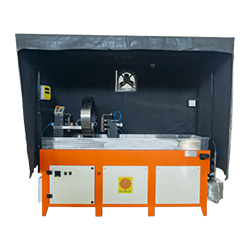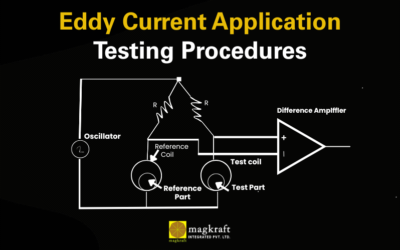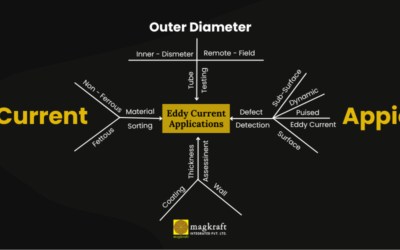Homepage > Ring Gears
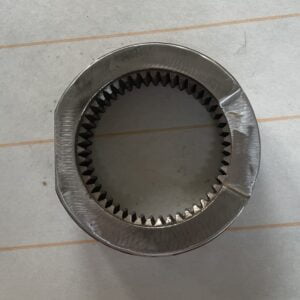
Like all other parts, ring gears also require a magnetic field in two perpendicular directions in order to check defects in all directions. A circular magnetic field is generated by passing a central conductor made from copper through the ring and passing current through this conductor. If the diameter of the ring is small, the conductor can be placed at the centre of the ring, and current can be given as per the following formula.
Head Shot Current = 20 X Diameter(mm)
In the above formula, the diameter should be taken as the outer diameter of the ring.
Picture of ring gear with the central conductor in the centre
For larger rings, an offset conductor method can be used in order to test the part on a lower amperage. In this method, the conductor is placed on one side of the inner periphery of the ring gear. The periphery covered by the conductor is equal to 4 times its diameter.
After one shot, the ring is rotated so that the next portion can be checked. This process is repeated until the entire ring is checked.
The diameter of the conductor can be adjusted so that the entire ring can be checked in 3-4 shots.
Head Shot Current = 20 X Diameter(mm)
In the above formula, the diameter should be taken as the outer diameter of the copper rod.
Picture of ring gear with the central conductor on the side
For longitudinal magnetization, an encircling coil is used. The current requirement for the coil must be established by using QQI shims, as standard formulas are not applicable to the geometry of the ring gear.
A horizontal bench-type machine is used to perform magnetic particle testing on ring gears. The ring gear is placed on the steady rollers placed on the machine. A copper conductor connected to a pneumatic cylinder is used for central conductor magnetization.
The arrangement is shown in the picture below.
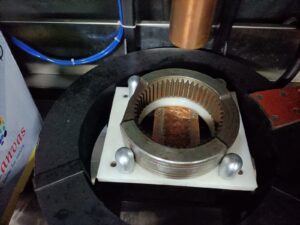
Testing Procedure
- Clean up & dry the Ring gear’s surface before inspecting.
- The Ring gear is placed on the steady rollers.
- Now apply the magnetic solution bath to the Ring gear.
- Press the ‘Cycle Start’ button.
- The central conductor comes out, passes through the gear & connects to the tail stock.
- Stop the flow of the bath.
- Now, the current passes through the central conductor.
- It shows up on the digital metering unit.
- Inspect the Ring gear under UV light for longitudinal defects. Rotate on steady rollers.
- If the offset conductor method is used, rotate the gear and repeat the above steps till the entire ring is covered.
- Press the ‘Cycle Start’ button.
- Now, again apply bath to the job.
- Stop the flow of the bath.
- Now the current passes through the coil.
- It shows up on the digital metering unit.
- Inspect the Ring gear under UV light for transverse defects. Rotate on Rollers
- Demagnetize
suitable products
Standard MPI Machines
Engineered for precision and efficiency, the Standard Bench Type Magnetic Particle Testing Machine is suitable for entry level testing.
PLC Controlled MPI Bench
With PLC Controlled bench type Magnetic Particle Inspection Machine, you can accurately control the process parameters for reilable results.
Multidirectional MPI Bench
The ultimate solution for robust non-destructive testing, this machine offers multi-directional magnetization for inspection in all directions in one shot..
Demagnetizers
Demagnetizers stand as a key tool in maintaining excellence in production, with the flexibility to handle different materials and magnetism levels, coupled with energy-efficient and user-friendly design.
BLogs
Coating Thickness Measurements by eddy current testing machine
Eddy Current Testing (ECT) is a non-destructive testing (NDT) method widely used to measure the thickness of non-conductive and conductive coatings over conductive substrates. This technique is especially useful for applications in aerospace, automotive, and...
Eddy Currents Application Testing Procedures
Eddy currents are electrical currents induced in a conductor by a time-varyingmagnetic field. Eddy currents flow in a circular pattern, but their paths are oriented perpendicular to the direction of the magnetic field. The Eddy current inspection method is a highly...
Magnaflux MPI Machine
PlC-Controlled MPI: Revolutionizing Non-Destructive Testing Magnaflux Magnetic Particle Inspection (MPI) is a key part of non-destructive testing (NDT). It helps find flaws on or near the surface of materials that react to magnets. PLC-controlled systems in Magnaflux...


